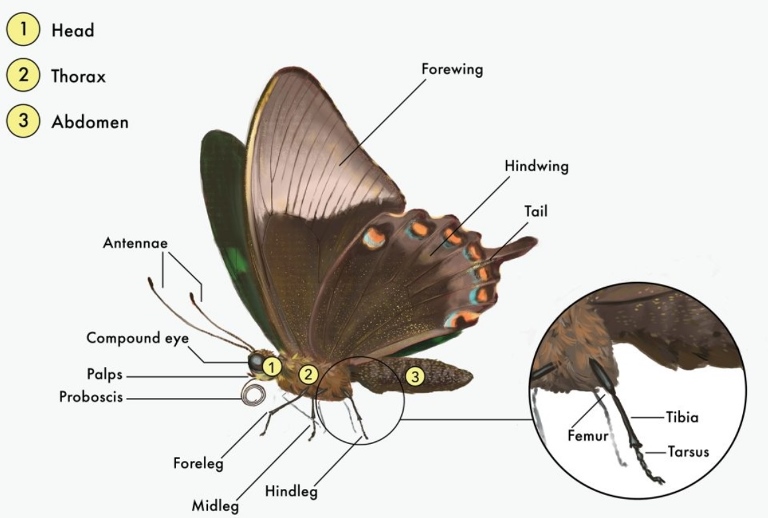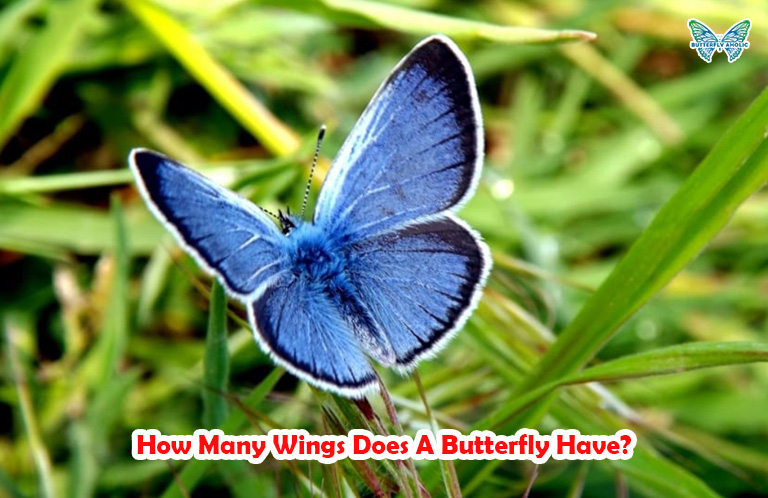How Many Wings Does A Butterfly Have?
A butterfly has four wings, even though we only see the two larger wings on most of them. If you use a magnifying glass to observe them, you will also spot tiny scales on their wings.
As butterflies are the only insects that have scaly wings, we are right to expect special functions other than making their bodies float. These tiny wings indeed hide a world of wonders within them.
What you will learn after reading this article:
- The number of wings a butterfly has.
- The structure of butterfly wings.
- Explanation for the color of butterfly wings.
- Other functions of butterfly wings.
- Can butterflies fly with damaged wings?
2 Pair Of Wings On A Butterfly
The most general opinion we can ascertain is that each butterfly has two pairs of wings. The upper and larger wings are the forewings, while the under and smaller wings are the hindwings.
A moth has four wings with a similar structure and function because they are from the same taxonomic group of insects.
A more thorough observation will show you the scales on these wings. Each of them has a specific color, such as red, white, black, yellow, and any colors you might have seen on a butterfly before.
Why?
These scales carry pigments, hence they can absorb and reflect corresponding light, and our eyes pick up the colors. They have the same components as hair, so they are quite fragile and even flaky if rubbed in the slightest.
Furthermore, in case you haven’t noticed, the patterns on butterfly wings are symmetrical, meaning one side is the mirrored image of the other.
The main purpose of the scales on butterfly and moth wings is to aid with their flight.
- Make the flow of air smooth while the butterfly is flying.
- Absorb heat from the surroundings to retain necessary energy for the flight.
- Insulate and protect the butterfly.
Even more difficult and impossible to observe in a non-professional environment, a system of veins runs through all four wings and keeps them alive.
The veins are fragile and breakable, so it’s better to not touch a butterfly. It might not die if you ruin its wings, but the wings do more than flight and you are lowering its chance of survival here.

Love butterflies, check now: Butterfly Pillows & Butterfly backpacks
5 Facts About Butterfly Wings
Butterfly wings look like magic from our childhood fairytales, but they might carry more mysteries with them than you think!
Here are a few fascinating tidbits about them!
Not Just For Flying, They Have Other Functions
When not in danger, butterfly wings can help them appeal to potential mates! But when threatened, these tiny, frail things are great camouflage or distraction to keep them alive.
Butterflies Can Fly With Wings Damaged
Through the summer months, it is inevitable for the wings to take damage. So, how do they keep going with tattered wings?
The experts associate this phenomenon with the energy butterflies need for flying and conclude that butterflies don’t require big and strong wings to support their bodies. The excess area of the wings is meant for the additional functions we have mentioned.
However, once the wings are damaged, it is permanent. We recommend not trying to touch a butterfly for fun, as you might be reducing its chance of survival without knowing about it!
They Are Covered With Colored Scales
We can’t see it without tools, yet butterfly wings are coated with scales, which are flattened hair not at all larger than a dust particle. The scales break and fall off the wings very easily, although our eyes cannot capture the sight either.
Check more: 100+ Butterfly Quotes For Life, Love, Kids
Three Varieties Of The Butterfly Wings’ Scales
Despite their size, butterflies are a miraculous species. Even the tiny scales that we can’t detect with the naked eye are divided into three types.
- Pigmented scales: They contain chemicals we associate with pigments and contribute to the visible colors of butterfly wings. Chemicals can break down over time, which explains why the butterflies in amateur collections gradually lose their colors.
- Androconia scales: They produce pheromones instead of pigments for colors. Since pheromones are the main means of communication for butterflies, especially when they are searching for a mate, these scales are quite crucial too.
- Diffractive scales: They diffract light and contain no pigments, hence their colors are not chemical-based and will not fade. Their function is compared to a prism that we use to break the white light into a spectrum.
The Scales Aid In Survival
Some butterflies use their sets of wings to blend into the surroundings and hide from the dangers.
On the other hand, butterflies with prominent colors and patterns can distract or shock their enemies instead.
There are also poisonous butterflies that keep toxins in their wings so they can make predators sick and lose their appetite.
The Takeaways
A butterfly has four wings, two forewings & two hindwings, which are made of scales and veins. These wings seem extremely fragile, yet they are simultaneously crucial for butterflies.
Aside from flying, butterflies need their wings for mating, defending, and surviving.
If you have interesting stories about butterflies, please share them with us, but don’t forget to keep your hands off the fragile wings!

